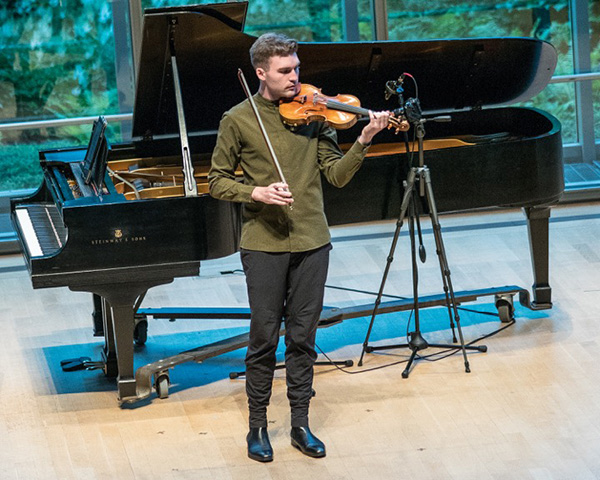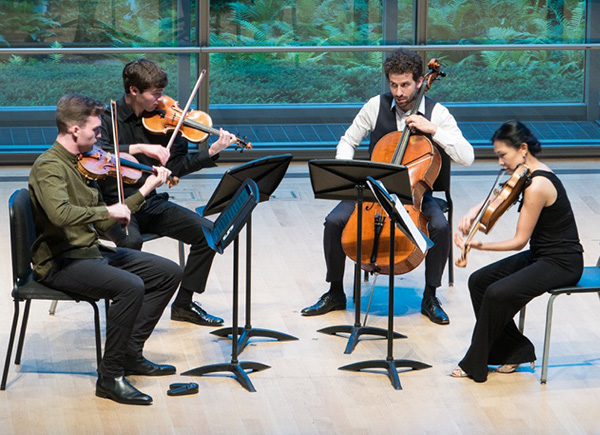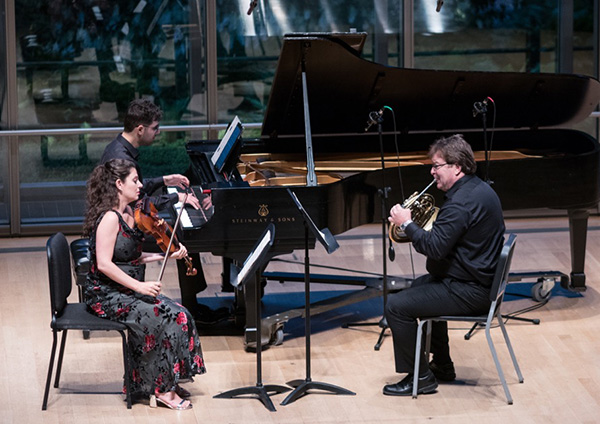by Timothy Robson

Violinist Alexi Kenney opened with the Adagio from Johann Sebastian Bach’s Sonata No. 1 in g, BWV 1001. Kenney played with flawless technique and a singing quality, paying close attention to the underpinnings of Bach’s melodic line, especially in resolving harmonic dissonances. Although he used a modern violin, he played with little vibrato, except as subtle ornamentation.
Before any applause could occur, Roman Rabinovich sat down to begin John Cage’s six-movement The Perilous Night for prepared piano as Kenney left the stage. It was an interesting theatrical touch that didn’t quite work — the audience was confused, and some people applauded even though the intention was clearly to move seamlessly from one piece to another.

The music, with its paper clips, nuts, bolts and other materials carefully inserted into the strings of the piano, is endlessly inventive: sometimes jazzily rhythmic, other times lyrical and almost melancholy, in a percussive way. Contrasting timbres in the prepared piano are differentiated by range, so by playing in different octaves the performer creates an array of arresting sounds. At one point I was unable to discern whether or not Rabinovich’s toe and heel tapping were part of the score or his own interpolation — either was possible. This was a brilliant and utterly convincing performance of music like no other. At the end, Kenney rejoined Rabinovich onstage for bows.

The music is mercurial, often stormy and unsettled. In the first movement fleeting passages remind one of Mendelssohn’s famous symphonic scherzos. The second seems to begin almost in mid-phrase, as if we had stepped in on the composer in mid-thought. Violent phrases are interspersed with gloriously lyrical moments. Sometimes the two violins act as a pair, in duo with the viola and cello also acting as a pair. The Adagio third movement is full of soaring melody, with significant sections in major mode, ending in a quiet, comforting resolution. In the fourth, Mendelssohn develops several brief musical motifs in alternately dramatic and lyrical passages.
The Chamberfest players caught all of the emotions in Mendelssohn’s music, but the performance was classically restrained, never maudlin. The quartet played cohesively, with excellent communication in matters of matching phrasing and dynamics.

The music is more grandiose than Mendelssohn’s trio, with fanfares, dramatic phrases and a wide variety of tonal qualities from the horn, from mellow to acidic. Caballero was in flawless command of his difficult part, although from where I sat the acoustic favored the piano and violin over the horn. (After the concert I spoke to another audience member who sat on the opposite side of the hall who felt that the horn dominated the proceedings.)
The third movement Adagio was especially beautiful, with its melancholy horn solo, but then a modulation to a major key introduced rhapsodic passages. The final Allegro featured triple-meter figures, alternating major and minor keys, but with a triumphal major conclusion. It was a heartfelt and romantic performance, deserving of the ovation it received.
Photos by Gary Adams.
Published on ClevelandClassical.com June 25, 2019.
Click here for a printable copy of this article



